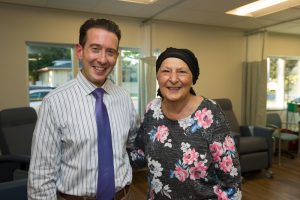
Early Signs of Inflammatory Breast Cancer
Regional Cancer Care Associates (RCCA) provides comprehensive treatment of cancer and blood disorders to patients throughout New Jersey, Connecticut, Maryland, and the Washington, DC, area.
HIPAA Alert: Potential Data Breach Learn More
Questions on Oncology, Hematology and/or Infusion Clinical Services due to COVID-19 Crisis – CALL 833-698-1623
Important Information for Our Patients Regarding the Coronavirus.
RCCA Providing Area Cancer Patients with Access to Care During Coronavirus Outbreak
RCCA Offering Patients Virtual Visits During Coronavirus Pandemic
Breast cancer develops when cells in a person’s breast grow abnormally and develop into tumors. Tumor cells can invade surrounding breast tissue and spread to other parts of the body.
In the United States, breast cancer is one of the most common types of cancer among women. While it is rare, breast cancer can also affect men. The American Cancer Society estimates that roughly 297,000 women and 2,800 men will be diagnosed with breast cancer in 2023.

Staging is a method physicians use to describe the extent of a patient’s breast cancer. Breast cancer stages are based on the size of the tumor, whether cancer is present in the lymph nodes, and whether cancer has spread to other parts of the body. Staging guides oncologists in determining the best course of treatment for a particular patient.
There are five stages of breast cancer.
DCIS, or Stage 0 breast cancer, is the earliest stage. Pre-invasive or non-invasive cancer cells are present in the milk ducts but have not spread to nearby tissue. DCIS is diagnosed with a mammogram and needle biopsy and usually is treated with a lumpectomy and radiation therapy. DCIS is very treatable and rarely recurs after surgery.
In Stage I breast cancer, tumor cells have spread to nearby breast tissue, but are still limited to a small area. Substages are:
Surgery is the primary treatment option for Stage I breast cancer and may be followed by radiation or hormone therapy. The five-year survival rate at this stage is 98% to 100%.
Stage II is divided into two substages:
Usually, Stage II breast cancer is treated with more than one type of therapy to eliminate as many cancer cells as possible and to lower the chance of recurrence. Therapies can include surgery, radiation, and chemotherapy. Five-year survival rates for Stage II are still very good; Susan G. Komen® reports a 90%-99% five-year survival rate for Stage II breast cancer.
In this stage, cancer has spread further into the patient’s breast or lymph nodes. There are three substages:
In Stage IIIC, treatment typically is multimodal; many patients will begin with chemotherapy and have radiation or surgery to remove the breast tumor or the axillary (underarm) lymph nodes.
As the most advanced stage of breast cancer, Stage IV indicates that cancer has spread to the patient’s lymph nodes and other parts of the body beyond the breast. Also known as metastatic breast cancer, Stage IV cancer can spread to the bones, liver, brain, and other parts of the body. Symptoms of metastatic breast cancer may include severe bone pain, changes in speech or vision, or persistent headaches. Because there is no known cure for metastatic breast cancer, treatment will focus on shrinking or slowing the growth of tumors, relieving symptoms, and prolonging life while maintaining a good quality of life. The last several years have seen a dramatic expansion in treatment options for metastatic breast cancer, accompanied by gains in survival.

A rare condition, IBC is a type of invasive ductal carcinoma. Symptoms of IBC include:
Breast cancer that comes back after treatment is completed is known as recurrent breast cancer. This can happen when undetected cancer cells multiply and grow. Recurrent breast cancer can develop months or even years after a patient’s initial treatment is completed. Treatment for recurrent breast cancer may include:
Mastectomy may improve survival rates for patients with recurrent breast cancer.
When it comes to breast cancer care, each patient is different. With recent advances in genetic testing, oncology teams can now deliver personalized, precision treatment plans for patients. Personalized medicine includes using blood testing for specific biomarkers or tumor biopsy sampling to help guide treatment. Doctors also can perform drug-gene testing to gauge how a patient’s body might process certain cancer drugs. This helps determine the best medications and dosages for a patient.
There are several surgical procedures commonly used in treating breast cancer. In early-stage cancers, patients often can choose between a lumpectomy, also known as breast-conserving surgery (BCS), or a mastectomy:
If cancer cells have spread to the lymph nodes, additional surgeries may be recommended:
The sentinel node is the lymph node that cancer is most likely to spread to first. For patients with breast cancer, that’s usually one of the underarm lymph nodes. An SLNB may be performed during a lumpectomy or as a separate procedure. If no cancer is found in a sentinel node, it is unlikely that cancer cells have spread to lymph nodes in other parts of the body.
If an SLNB does identify cancer in underarm lymph nodes, a patient may need to have multiple underarm lymph nodes removed. This can stop the cancer from spreading to other lymph nodes and reduce the likelihood of cancer recurrence.
While all forms of surgery carry some degree of risk, breast cancer is far riskier if left untreated. Recovery time will vary: most lumpectomy patients can go home the same day, while a mastectomy usually requires a hospital stay.
Radiation therapy uses high-energy beams to kill cancer cells. In breast cancer treatment, radiation therapy often is used after surgery to destroy any remaining cancer cells. The main types of radiation used in breast cancer treatment are external beam radiation therapy and brachytherapy, which uses internal radiation to destroy cancer cells. Side effects of radiation can include skin peeling and redness, swelling, and fatigue.
Systemic therapy refers to any treatment that uses medications or substances that travel through the bloodstream, treating the entire body instead of one specific area. Systemic therapies for breast cancer include:
These therapies may be used before surgery to shrink the size of a tumor. Hormone therapy is sometimes used after initial treatment is complete to reduce the likelihood of cancer recurrence. While chemotherapy, immunotherapy, and targeted therapy can cause side effects, a patient’s oncology team can provide strategies and medications for managing those issues.
Some patients benefit from massage, acupuncture, and other complementary and alternative therapies, which can help reduce a person’s stress levels and mitigate the symptoms associated with cancer treatment. Complementary therapies can be integrated into a patient’s treatment plan but should be discussed with a patient’s oncologist before they are initiated.
Breast cancer survivors may face long-term side effects or other health problems, so developing a survivorship care plan that includes long-term monitoring is important. Survivors are encouraged to take advantage of supportive services and resources offered by their treatment center.
Advances in breast cancer research are occurring at a rapid pace and are driving the development of new therapies and treatment strategies. Regional Cancer Care Associates is proud to contribute to these advances through its comprehensive breast cancer clinical trials program.
Risk factors for breast cancer include:
Metastatic breast cancer usually is treated with systemic therapies, including chemotherapy, immunotherapy, and targeted therapies.
During radiation, a patient will lie on a treatment table while a machine moves around the patient, delivering doses of radiation. Each appointment usually takes less than an hour. A patient may have multiple appointments over several weeks.
While early detection generally ensures better treatment outcomes, cancer research is always advancing and identifying new insights to inform treatment approaches for all stages of breast cancer. At Regional Cancer Care Associates, the oncology team has extensive experience in treating breast cancer at each stage. Regional Cancer Care Associates has more than 20 locations throughout New Jersey, Connecticut, Maryland, and the Washington, D.C., area, so patients can access care for cancer or blood disorders close to home. Contact us for more information or request an appointment today.
No matter which stage your breast cancer falls under, the team of experts at Regional Cancer Care Associates won’t let you fight alone. Once we determine the stage of your cancer, we will collaborate with our on-site oncologists, plastic surgeons and other specialists to devise an effective course of treatment. To learn more, contact us today.

Regional Cancer Care Associates (RCCA) provides comprehensive treatment of cancer and blood disorders to patients throughout New Jersey, Connecticut, Maryland, and the Washington, DC, area.

When people think of breast cancer, they generally think of it affecting women. However, in rare circumstances, breast cancer can affect men, most commonly in

First diagnosed with breast cancer in 1992, she has persevered in her battle against the disease for more than 30 years.

Regional Cancer Care Associates is one of fewer than 200 medical practices in the country selected to participate in the Oncology Care Model (OCM); a recent Medicare initiative aimed at improving care coordination and access to and quality of care for Medicare beneficiaries undergoing chemotherapy treatment.